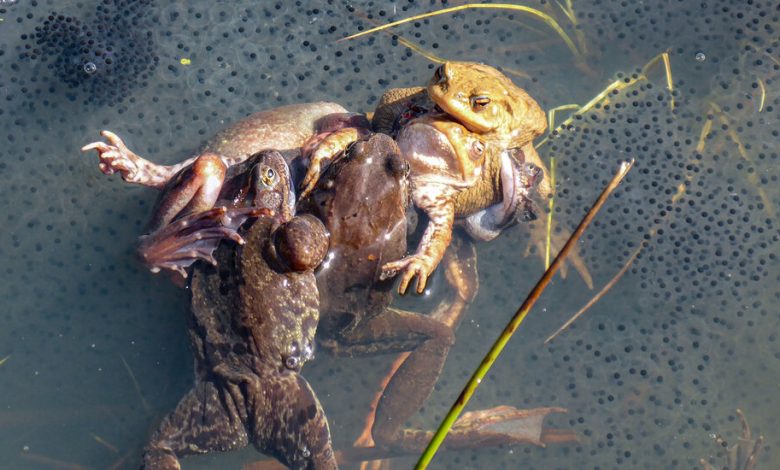When Female Frogs Face the Mating Ball, They Pretend to Croak

Some male frogs cannot take a hint. Come spring, they pile onto potential mates in such a determined frenzy that the females may drown.
That’s why the females have developed tricks for getting away. A study published Wednesday in the journal Royal Society Open Science shows that female frogs use evasive maneuvers to flip males off them. They also disguise their identities. They sometimes even fake their own deaths.
Carolin Dittrich, a postdoctoral researcher at the Konrad Lorenz Institute of Ethology in Vienna, made the discovery by accident.
She was studying the mating habits of the European common frog. These amphibians lead solitary lives except for around two weeks every spring when they meet at pools for a free-for-all reproductive event called explosive breeding.
In their haste, males may use the spiny pads on their thumbs to grip onto a female who already has a partner — or several partners. You might see six or seven males attached to a single female.
“It can look disgusting, I have to say,” Dr. Dittrich said. A female caught in this entanglement, called a mating ball, can perish — perhaps by drowning, or being crushed.
Dr. Dittrich wondered whether male frogs prefer females with larger bodies. As part of her doctoral research, she brought wild frogs to the lab, where she put two females into a tank with each male. She turned on a video camera and gave the frogs an hour of privacy.
In one of the first videos, she saw a male dragging a female who had gone stiff, her limbs splayed out. “At first I thought, Oh my God, this can’t be,” Dr. Dittrich said.
She hadn’t found any dead frogs in her tanks, yet the female on her screen looked distinctly unalive. “I was super surprised, and a bit worried,” Dr. Dittrich said.
After a couple of minutes, the male gave up and moved on to the other female in the tank. When the new partners bumped into the unmoving frog, she revived and swam away.
Other videos revealed that this behavior wasn’t a fluke: One-third of females faked death when a male grabbed them.
Playing dead — also called thanatosis, or tonic immobility — is widespread in the animal kingdom, but is usually used to avoid a predator. Playing possum to avoid mating is much rarer. It’s been seen in females of one species of newt. Male spiders sometimes fake death so their mates won’t cannibalize them.
No one can say what’s in the mind of a stressed animal during tonic immobility. “We don’t know if it’s a conscious decision to play dead,” Dr. Dittrich said. But the result is that the animal, at least to human eyes, looks like it has croaked.
In Dr. Dittrich’s experiments, that wasn’t the only way females tried to escape mating. More than 80 percent of females rolled in the water to shake off their partners.
Additionally, nearly half of females gave distinct calls that sounded just like the noise a male makes when he’s accidentally grabbed by another male. The females seemed to be impersonating the males, Dr. Dittrich said, so that their suitors would look elsewhere.
Their evasive maneuvers, often used in combination, worked. Out of 54 females grabbed by a male, 25 managed to shake him off.
Dr. Dittrich dug deep in the scientific literature and found a couple of references to such behaviors, one more than 250 years old. Even so, she said, more modern researchers have described female frogs as passive participants in breeding events. Yet her results suggest that females aren’t defenseless. They have an arsenal of tactics to fight back against forceful males, and keep themselves alive.
As for Dr. Dittrich’s original question when she played amphibian matchmaker in the lab — do male frogs use body size to select the best mate? — the answer is no.
“They are really not choosy at all,” Dr. Dittrich said. “They grab whatever they can.”




